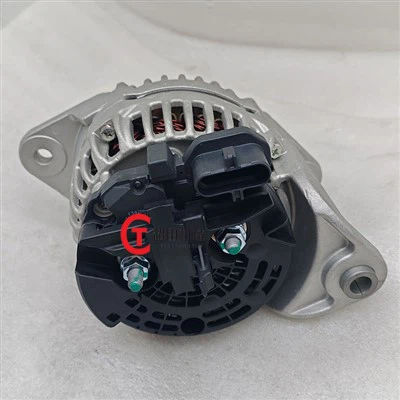As a seasoned fuel injector supplier, I've witnessed firsthand the critical role that fuel injectors play in an engine's performance. One of the most significant factors affecting engine combustion is the fuel injector spray angle. In this blog post, I'll delve into how the fuel injector spray angle impacts combustion, and why it matters for your engine's efficiency and power.
Understanding Fuel Injector Spray Angle
The fuel injector spray angle refers to the angle at which the fuel is dispersed as it exits the injector nozzle. This angle can vary widely depending on the design of the injector and the requirements of the engine. A narrow spray angle concentrates the fuel in a smaller area, while a wide spray angle distributes the fuel over a larger area.
The spray angle is carefully calibrated during the design process to ensure optimal fuel-air mixing. This is crucial because efficient combustion requires a homogeneous mixture of fuel and air. If the fuel is not properly mixed with the air, combustion will be incomplete, leading to reduced power output, increased fuel consumption, and higher emissions.
Impact of Spray Angle on Combustion Efficiency
The spray angle has a direct impact on the combustion efficiency of an engine. A well-designed spray angle can promote better fuel-air mixing, which in turn leads to more complete combustion. When the fuel is evenly distributed throughout the combustion chamber, the flame front can propagate more uniformly, resulting in a more efficient release of energy.
For example, in a diesel engine, a narrow spray angle can be beneficial in direct injection systems. This allows the fuel to be injected directly into the combustion chamber at high pressure, creating a fine mist that can mix quickly with the compressed air. The narrow spray angle helps to ensure that the fuel reaches the center of the combustion chamber, where the air is the most compressed and the temperature is the highest. This promotes rapid ignition and efficient combustion.
On the other hand, a wide spray angle may be more suitable for some gasoline engines. In port fuel injection systems, the fuel is injected into the intake port before entering the combustion chamber. A wide spray angle can help to coat the intake valves and the walls of the intake port, improving the evaporation of the fuel and enhancing the fuel-air mixing in the intake manifold.


Influence on Emissions
The fuel injector spray angle also has a significant impact on engine emissions. Incomplete combustion can result in the formation of harmful pollutants such as carbon monoxide (CO), hydrocarbons (HC), and particulate matter (PM). By optimizing the spray angle, we can reduce these emissions and make engines more environmentally friendly.
A proper spray angle ensures that the fuel is burned more completely, reducing the amount of unburned fuel and pollutants released into the atmosphere. For instance, in a diesel engine, a well-calibrated spray angle can help to minimize the formation of soot particles. Soot is a major component of particulate matter emissions, and reducing its formation can improve air quality and comply with strict emission regulations.
Effect on Engine Power and Performance
The spray angle can also affect the power and performance of an engine. A more efficient combustion process, facilitated by an appropriate spray angle, can lead to increased power output and torque. When the fuel is burned more completely, more energy is released, which can be converted into mechanical work.
In addition, a well-designed spray angle can improve the engine's responsiveness and throttle response. By ensuring a consistent and homogeneous fuel-air mixture, the engine can operate more smoothly and deliver power more quickly. This is particularly important in high-performance engines, where every bit of power and responsiveness counts.
Our Fuel Injectors and Spray Angle Optimization
At our company, we understand the importance of the fuel injector spray angle in engine performance. That's why we invest heavily in research and development to optimize the spray angle of our fuel injectors. Our engineers use advanced computational fluid dynamics (CFD) simulations and experimental testing to fine-tune the spray angle for each specific engine application.
We offer a wide range of fuel injectors with different spray angles to meet the diverse needs of our customers. For example, our 0445120066 Diesel Fuel Injector For EC240B EC290B is designed with a carefully calibrated spray angle to ensure efficient combustion in heavy-duty diesel engines. Similarly, our 127-8209 Fuel Injector For 3116 3114 Engine E320B E200B and Fuel Injector 387-9428 For Engine C7 950H 962H are engineered to provide optimal fuel-air mixing in their respective engine models.
Conclusion
In conclusion, the fuel injector spray angle is a critical factor in engine combustion. It affects combustion efficiency, emissions, power output, and overall engine performance. By choosing the right fuel injector with an optimized spray angle, you can improve the efficiency and reliability of your engine, reduce emissions, and save on fuel costs.
If you're interested in learning more about our fuel injectors or need help selecting the right one for your engine, please don't hesitate to contact us. We're here to provide you with the best solutions and support for your fuel injection needs.
References
- Heywood, J. B. (1988). Internal Combustion Engine Fundamentals. McGraw-Hill.
- Stone, R. (1999). Introduction to Internal Combustion Engines. Society of Automotive Engineers.
- Taylor, C. F. (1985). The Internal Combustion Engine in Theory and Practice. MIT Press.






